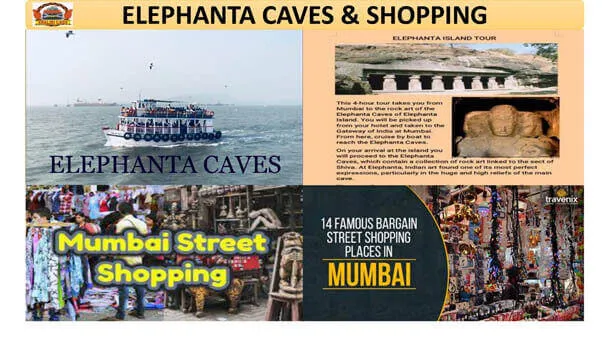Elephanta Caves & Shopping

We are the best in the city for providing the Elephanta Caves taxi service. The best option for traveling for Elephanta Caves is to book a cab that can be done with ease with our online booking mobile Shalini Cab App.To Book a Taxi for Elephanta Caves & Shopping in Mobile App Elephanta Caves & Shopping in Mobile App Shalini Cab App.
Pickup Location: Should be in Mumbai cities only M.M.R.D.A Region.
Drop Location: Should be Enter same and Select Package Option.
Now you do not need to do the stressful journey by bus when you can travel in the comfort of the AC car by hiring a taxi for Elephanta Caves. We can help you avoid all the hassles of traveling on public transport. Choose us for Elephanta Caves taxi services as it is the best option one can get in Mumbai city. With excellent services, you can now book your cabs in Mumbai for Airport Taxi, City Taxi, Rental Taxi, Outstation, and Oneway trips. We have a wide range of taxis for travel to Mumbai City. You need to spare a minimum of one days to visit all the places. Just by paying a nominal booking amount you can book your AC car.
The Elephanta Caves are a collection of cave temples predominantly dedicated to the Hindu god Shiva, which have been designated a UNESCO World Heritage Site. They are on Elephanta Island, or Gharapuri (literally meaning “the city of caves”), in Mumbai Harbour, 10 kilometres (6.2 mi) east of Mumbai in the Indian state of Maharashtra. The island, about 2 kilometres (1.2 mi) west of the Jawaharlal Nehru Port, consists of five Hindu caves, a few Buddhist stupa mounds that date back to the 2nd century BCE,and two Buddhist caves with water tanks.
The Elephanta Caves contain rock-cut stone sculptures, mostly in high relief, that show syncretism of Hindu and Buddhist ideas and iconography. The caves are hewn from solid basalt rock. Except for a few exceptions, much of the artwork is defaced and damaged. The main temple’s orientation as well as the relative location of other temples are placed in a mandala pattern. The carvings narrate Hindu mythologies, with the large monolithic 5.45 metres (17.9 ft) Trimurti Sadashiva (three-faced Shiva), Nataraja (Lord of dance) and Yogishvara (Lord of Yoga) being the most celebrated.
These date to between the 5th and 9th centuries, and scholars attribute them to various Hindu dynasties. They are most commonly placed between the 5th and 7th centuries. Many scholars consider them to have been completed by about 550 CE.
They were named Elefante – which morphed to Elephanta – by the colonial Portuguese who found elephant statues on the caves. They established a base on the island. The main cave (Cave 1, or the Great Cave) was a Hindu place of worship until the Portuguese arrived, whereupon the island ceased to be an active place of worship. The earliest attempts to prevent further damage to the caves were started by British India officials in 1909.The monuments were restored in the 1970s. It is currently maintained by the Archaeological Survey of India (ASI).
Description
Overview of Elephanta Caves site.
The island has two groups of rock-cut caves, hewn from solid basalt rock. The larger group of caves, which consists of five caves on the western hill of the island, is well known for its Hindu sculptures. The primary cave, numbered as Cave 1, is about 1.0 km (0.62 mi) up a hillside, facing the Mumbai harbour. Caves 2 through 5 are next to Cave 1 further southeast, arranged in a row. Cave 6 and 7 are about 200 m (660 ft) northeast of Cave 1 and 2, but geologically on the edge of the eastern hill.
The two hills are connected by a walkway. The eastern hill is also called the Stupa hill, while the western hill is called the Canon hill, reflecting their historic colonial-era names, the ancient Stupa and the Portuguese era firing Canons they host respectively.
All the caves are rock-cut temples that together have an area of 5,600 m2 (60,000 sq ft). At their most elaborate, they have a main chamber, two lateral chambers, courtyards, and subsidiary shrines, but not all are so fully developed. Cave 1 is the largest and is 39 metres (128 ft) deep from the front entrance to the back. The temple complex is primarily the abode of Shiva, depicted in widely celebrated carvings which narrate legends and theologies of Shaivism. However, the artwork reverentially displays themes from Shaktism and Vaishnavism traditions of Hinduism as well.
Cave 1: Main, Great Cave
The main cave, also called Cave 1, Grand Cave or the Great Cave, is 39.63 metres (130.0 ft) square in plan with a hall (mandapa). The basic plan of the cave can be traced back to the plan of the ancient Buddhist viharas, consisting of a square court surrounded by cells, built from about 500 to 600 years before in India. The Cave has several entrances, the main entrance is unassumingly small and hides the grand hall inside. The main entrance faces north, while two side entrances face east and west. The cave’s main entrance is aligned with the north–south axis, unusual for a Shiva shrine (normally east–west). However, inside is an integrated square plan Linga shrine (garbha-griya) that is aligned east–west, opening to the sunrise.


